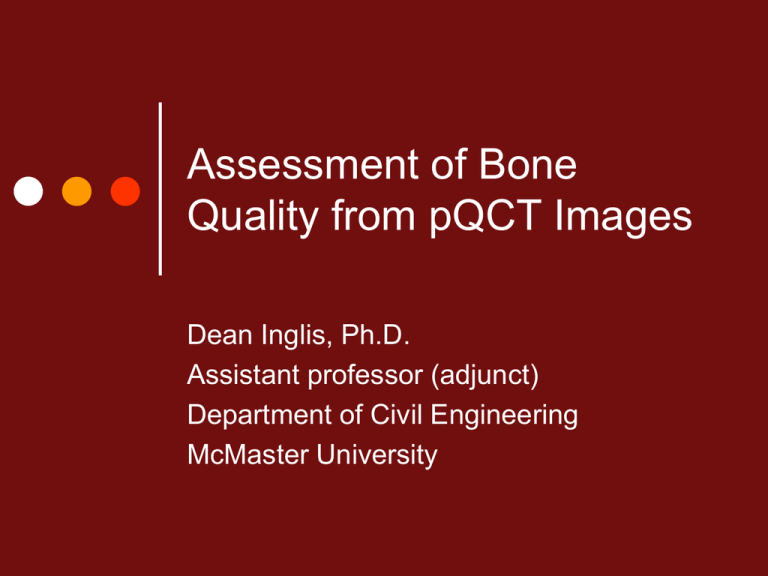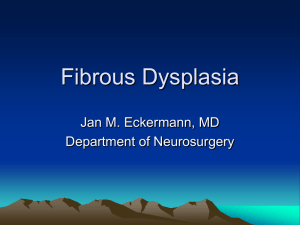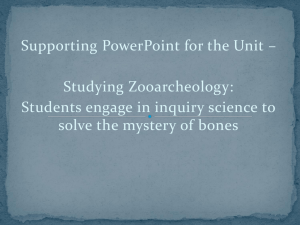BSM Spring 2010 presentation by Dean Inglis.
advertisement

Assessment of Bone Quality from pQCT Images Dean Inglis, Ph.D. Assistant professor (adjunct) Department of Civil Engineering McMaster University Overview CT image source, formation and characteristics Image segmentation Bone morphometry 2D stereology: basic principles, assumptions 3D stereology: mean intercept lengths, Eigen analysis, interpretation Model independent measures Topology: Euler number, Structure Model Index Summary What is Peripheral Computed Tomography? pQCT (2D), hr-pQCT (3D) CT imaging techniques that target peripheral sites use computer controlled X-ray source + detector system multiple X-ray 1D/2D projections reconstructed into 2D slice/3D volume images CT basic principles electron beam strikes tungsten target and generates polychromatic X-ray beam spectrum source CT basic principles X-rays pass through a sample and are attenuated: I = Ioe - ∫ u(x,y) ds I = intensity at the detector Io= intensity of the source u(x,y) = attenuation characteristics of the sample: depend on atomic number (density) attenuation is integrated along a ray CT basic principles emergent X-rays detected by a phosphor detector coupled to a CCD camera CT image formation detection of many rays results in a projection (silhouette) of the sample many projections are generated by rotating the source and detector around the sample image is reconstructed using convolution back-projection CT image formation CT image formation CT image characteristics raw CT data represent linear attenuation coefficients coefficients are converted to CT numbers, Hounsfield Units (HU), in the reconstruction process pQCT calibrates HU into density: g/cm3 Image characteristics an image in its most basic sense is a matrix of numbers a 2D matrix has topology consisting of pixels (picture elements) 8-connected to their neighbours images have a spatial origin, eg. (0,0,0) mm, and finite spacing between their pixel centers, eg. 0.5×0.5×0.5 mm3 spacing partly governs ability to resolve small features accurately pQCT resolution: 0.2×0.2×0.5 mm3 (non-isotropic) hr-pQCT resolution: 0.08×0.08×0.08 mm3 (isotropic) Topology example: 6x5 image 7 4 8 3 xi,yi 1 6 2 5 Image characteristics a 3D image can be considered as a stack of 2D images having thickness pixels are now called voxels (volume elements) and are 27-connected topologically Image segmentation segmentation is the task of classifying pixels/voxels based on their value and topological affinity segmentation is used to isolate features of interest (bone) in an image Image segmentation Image segmentation thresholding: P(x,y,z) = Po(x,y,z) < t ? 0 : Po(x,y,z) Image segmentation binarization: P(x,y,z) = Po(x,y,z) < t ?0:1 Image segmentation some problems to consider… how do we pick “t” without bias? how do we pick one bone from another? how do we pick bone constituents (cortex vs trabeculae)? Image segmentation bone images consist of 2 pixel groups: bone and soft tissue (or background): a histogram of a bone image appears bimodal segment bone from nonbone using an automated thresholding scheme to determine “t” Otsu’s method minimizes the error of misclassifying a non-bone pixel as bone and vice versa by minimizing the within-class variance of the two groups Otsu : t Image segmentation at low resolution Otsu fails for bone within bone: cortical bone vs. trabecular bone trabecular bone vs. marrow Image segmentation many other schemes exist: livewire tracing, active contours, level sets desirable characteristics of any method: simple, fast, reproducible, automated, gets the job done! Bone morphometry given a segmented image of bone, what can be measured? HU’s represent attenuation: analog for density calibration allows volumetric BMD (g/cm3): BMD = ∑ [Pi != 0 ? m×Pi + b : 0 ] segmentation provides volume (cm3): V = [ ∑ Pi != 0 ? 1 : 0 ]×dx×dy×dz BMC = BMD × V (g) Bone morphometry what is structure and is it important? 3 plank beam: σ = My/I I-beam / block ~ 4 for L / t = 5 in addition to density (stiffness), the spatial arrangement of material (structure) contributes to strength BMD/BMC is limited: no information on spatial arrangement Bone morphometry how can structure be measured? before CT, samples were embedded in resin, sliced and polished, and photomicrographed 2D images: area, perimeter length, number more information (e.g., thickness, spacing) can be inferred using stereology: mathematical science based on geometric probability 2D stereology Parfitt et. al. developed the “parallel plate model” for analyzing 2D images (J. Clin. Invest. 1983, v72, 1396-1409) key assumptions: -trabecular bone comprised mainly of interconnected plates -tissue is isotropic -sample is uniformly randomly obtained 2D stereology basic 2D quantities: PB = bone perimeter length (mm) AB = bone area (mm2) AT = tissue section area (mm2) (bone + marrow) 2D stereology bone volume fraction (%): TBV = BV/TV = AB / AT Bone surface density (mm2/mm3): Sv = BS/TV = PB / AT bone surface to volume ratio (mm2/mm3): S/V = BS/BV = PB / AB mean trabecular plate thickness (mm): MTPT = Tb.Th = 2 AB / PB mean trabecular plate density (/mm): MTPD = Tb.N = BV/TV / Tb.Th = PB / (2 AT) mean trabecular plate separation (mm): MTPS = Tb.Sp = 1 / Tb.N – Tb.Th = 2 (AT – AB) / PB 3D stereology trabecular bone is a highly organized 3D oriented structure 3D provides additional metrics: surface area, volume, orientation a stereologic technique using a 3D array of line probes provides BV/TV, Tb.Th, Tb.N, and Tb.Sp 3D stereology considering the 2D case, focus on the boundary between bone and marrow within a circular ROI overlay an array of test lines spaced δ apart the sum of test line lengths, L, is orientation independent this is only true with uniform sampling: circular ROI 3D stereology consider the intercepts between test lines and boundaries the number of intercepts, Tb.N(θ), depends on orientation the sum of intercept lengths, ∑I, is orientation independent as δ→0 BV/TV = ∑I / L mean intercept length, a.k.a. Tb.Th: MIL(θ) = ∑I / Tb.N(θ) the number of intercepts in marrow, M.N(θ), is not equal to Tb.N(θ) Tb.Sp(θ) = ( L - ∑I ) / M.N(θ) 3D stereology in 2D, an ellipse can be fit to data from N orientations Let (xi, yi) = (cos(θi), sin(θi)), i = 1→N Tb.N(θi) = A xi2 + B xiyi + Cyi2 least squares fitting gives A,B and C arranging A, B, C into a 2×2 matrix: A ½B ½B C Eigen analysis gives the orientation and lengths of the principle axes of the ellipse anisotropy is defined as the ratio of the axes’ lengths: L2 / L1 y L2 Lθ1 x 3D stereology θ z in 3D, a 3D array of parallel test lines probes the image uniformly within a spherical ROI “uniformly” means equal area partitions of the surface of a unit sphere or many x random orientations orientation of the lines is defined in terms of two angles: θ, φ ( xi, yi, zi ) = ( sin(θi)cos(φi), sin(θi) sin(φi), cos(θi) ) Tb.N( θi, φi ) = A xi2 + B yi2 + C zi2 + D xiyi + E xizi + F yizi φ y 3D stereology least squares fitting gives A,B,C,D,E,F A,B,C,D,E,F are arranged to form a 3×3 matrix Eigen analysis gives the orientation and lengths of the 3 principle axes of the ellipsoid anisotropy is defined by the ratios of the axes’ min to max lengths: L3 / L1, L2 / L1 z L2 x L3 L1 y Model independent measures Tb.Th and Tb.Sp can be measured without model assumptions find the medial axes (2D) or surface (3D) of the bone (marrow) fit maximal non-overlapping spheres within bone (marrow) analyze the histogram of spherical diameters works for any ROI shape Topology the Euler Number is an index of connectivity of trabecular bone measures redundant connectivity: the degree to which parts of the object are multiply connected: Χ = β0 – β1 – β2 β0 is the number of isolated objects = 1 for bone β1 is the connectivity β2 is the number of enclosed cavities = 0 for bone β1 is calculated by analyzing the local neighbourhood connectivity of each voxel representing bone works for any ROI shape Topology the Structure Model Index, SMI, is a measure of the degree of convexity of a structure in bone, it indicates the relative prevalence of rods and plates SMI is calculated by differential analysis of the triangulated surface of the bone: SMI = 6 BV ( dBS/dr ) / BS2 dBS/dr is estimated by translating the surface by a small distance, dr, in its normal direction: dBS/dr = (S´ - S) / dr an ideal plate, cylinder (rod) and sphere have SMI values of 0, 3, and 4 Topology a shell… and its inflated surface transition of a rod to a plate… perforation of a plate… h:r == 0.05, r:R 5, 1, 0.5, 10, 0.25, 0.75, 0.87, 0.95, 0, SMI 0.05, 0.5, SMI SMI SMI SMI SMI SMI ==== 3.02 2.61 = 0.35 = 2.97 =2.00 0.69 0.35 0.49 1.16 1.70 2.09 0.39 Summary pQCT is an X-ray tomographic imaging modality pQCT provides high resolution 2D / 3D images images of trabecular (and cortical) bone can be digitally partitioned into bone/non-bone bone (quality) can be numerically characterized in terms of BMD and structure structure can be quantified using stereological and topological methods stereological methods may have embedded assumptions / limitations model independent measures Finis! further reading: http://www.scanco.ch/support/generalfaq.html#c781 http://www.stratecmed.com/en/prod_xct2000.php







